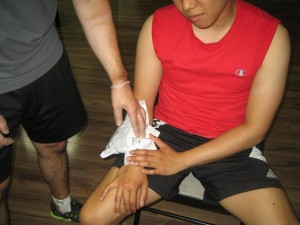A bruise typically forms once a blow breaks the blood vessels close to the skin surface, allowing a small amount of blood to leak into the tissues under your skin. The blood that is trapped appears as the black or bluish mark on the surface of your skin.
Types of bruises
There are three types of bruising that occurs during injuries.
- Subcutaneous – these bruises occur right beneath the skin
- Intramuscular – these bruises occur in the underlying muscle
- Periosteal – these are bruises that occur on the bones
Causes of bruises
Bruises that manifest without any reason on the knee might be due to bumping the area on a post, chair, bed frame or door frame without noticing. You might even notice a bruise but it is already healing.

Other common causes of bruises:
- Car accidents
- Sports injuries
- Blows
- Side effects of certain medications
The bruises that develop after sustaining a burn, cut, fall or injury are normal. On the other hand, it is not uncommon to develop a knot in the area where the bruise appeared. Bruises form as part of the natural healing process of the body. In most cases, it is not an issue to be concerned with. Nevertheless, if there is a wound that bruised then reopened and pus, blood or clear liquid is present, it is best to consult a physician since these are signs of infection.
How to prevent bruising
In order to prevent bruising, it is important to be careful when engaged in physical activities such as playing, climbing, driving and exercising. You can utilize pads on your knees, shins and elbows when playing sports in order to avoid bruises. The risk of getting bruises can be minimized when engaging in sports by wearing shoulder pads, shin guards, thigh pad and hip guards.
Simple steps to follow if skin is not broken
In case the skin is not broken, a bandage is not needed but it in order to improve the healing process, these steps should be followed.
- Raise the area that is injured
- With ice or a cold pack, apply it several times in a day for 1-2 days after the injury
- Rest the area that is bruised if possible
- For pain relief and to reduce swelling, acetaminophen or ibuprofen can be administered.
When to see your doctor
In some cases, there are indications where it is important to consult your doctor right away.
- Bruises that are unusually large or painful especially if they developed without any reason
- The individual develops bruises easily
- Individual experiences abnormal bleeding in other parts of the body such as from the nose or gums as well as in the eyes, urine or stool
- Individual has no history of bruising yet suddenly develops bruises.
Take note that these signs and symptoms can indicate a serious problem such as a blood-related disease or a blood-clotting problem. Bruises that are accompanied with headaches or persistent pain can also indicate a serious underlying disease and would surely require immediate medical attention. As part a standard first aid course, how to handle bruises is always covered.
